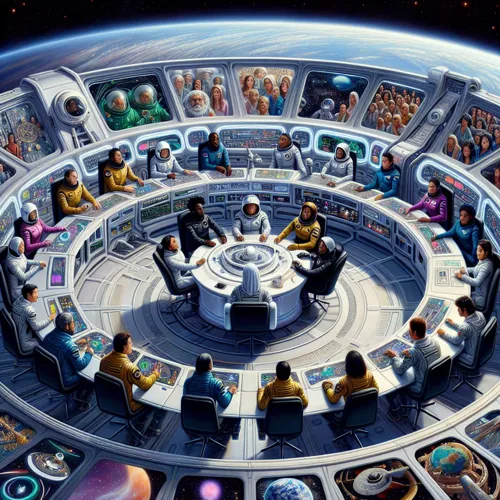The iconic series, Star Trek: The Next Generation (STTNG), debuted in 1987 and ran until 1994. It introduced audiences to a hopeful vision of humanity’s future set against the backdrop of space exploration aboard the USS Enterprise-D. While it initially drew viewers through its gripping stories, fascinating alien species, and compelling characters, it soon became apparent that there was another level to the series - it subtly wove together a tapestry of social commentary, presenting hopes for a better future and offering potential solutions to contemporary challenges.
Egalitarian Society One of the most striking elements of The Next Generation was its portrayal of an egalitarian society in which individuals from various backgrounds could work together as equals. In a time when civil rights movements were gaining momentum, this represented a hopeful vision of a society that had overcome systemic oppression and bias. It demonstrated the potential for cooperation and unity across race, gender, and species lines, foreshadowing possibilities for our future.
Environmental Concerns Environmental sustainability is another prevalent theme throughout The Next Generation. For instance, in episodes like “The Most Toys” (S3E14) and “Chain of Command” (S6E23 & S6E25), the Federation deals with situations caused by pollution and unregulated industrial practices that highlight our current environmental concerns. These stories serve as warnings against unchecked exploitation, offering viewers a sense of what could happen if we continue down our current path.
Technological Advancements A significant part of the STTNG’s hopeful vision involves technological advancement. Throughout the series, characters rely on advanced medical techniques, transportation systems, and communication devices that seem far beyond anything we have today. Yet, at their core, these technologies stem from humanity’s innate curiosity and ingenuity, offering inspiration for the next generation of scientists, engineers, and researchers to continue pushing boundaries in search of innovative solutions to complex challenges.
Diplomacy over Conflict One of the most consistent messages in STTNG is that diplomacy should always be preferred over conflict when engaging with alien species or resolving conflicts within the Federation. This theme is reinforced throughout numerous episodes, such as “The Enemy” (S3E9), where Captain Picard and Gul Madred learn to cooperate despite their contrasting ideologies. It emphasizes that understanding and respect for different perspectives can pave the way toward lasting peace and mutual respect among cultures and species.
Individualism vs Collectivism Another theme explored throughout The Next Generation is the balance between individual desires and collective goals, a timeless struggle in human societies. The series delves into this tension through various characters like Data, an android with an insatiable thirst for understanding humanity while striving to achieve personhood; or Worf, a Klingon who wrestles with his allegiance to both the Federation and his cultural heritage. In these explorations, we can see parallels with contemporary discussions about personal freedoms versus community obligations - and find that there is often room for compromise between seemingly conflicting ideologies.
Star Trek: The Next Generation may be set in the far-off reaches of space, but its messages remain as relevant today as they did when the series first premiered. As we continue to face pressing challenges on Earth, from environmental degradation to social inequality, these insights offer hope that, if we work together and embrace our collective strength, we can forge a brighter future for all
